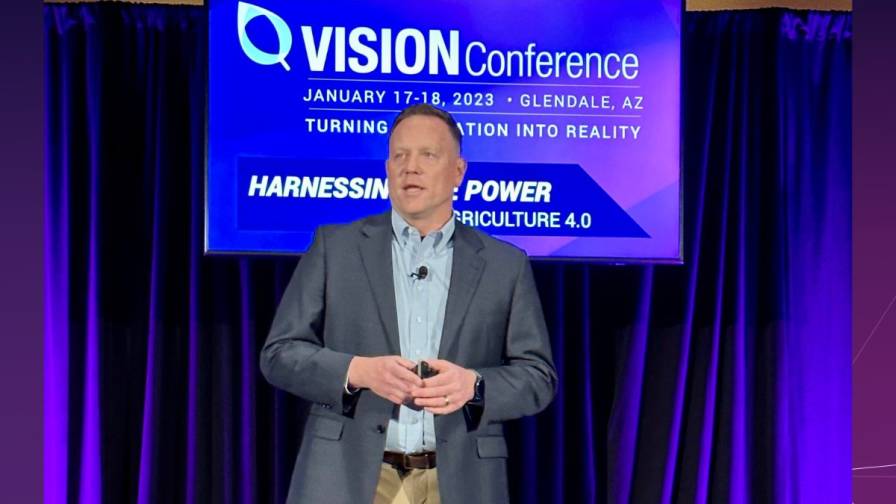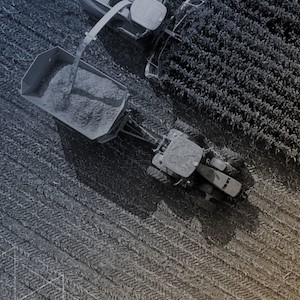Harnessing the Power of Agriculture 4.0: AWS Offers Insights on Where the Industry Is Heading

Amazon Web Services seems to have its hand in many parts of our lives. AWS, part of one of the world’s most recognized companies, is exploring artificial intelligence, the Metaverse, the Internet of Things and a variety of things that heralds the next generation of agriculture.
John Teeple, AWS Global Partner Leader, Agriculture, shared his thoughts on the future of agriculture during his keynote presentation “Harnessing the Power of Agriculture 4.0: Where Are We Going Next?” during Meister Media Worldwide’s VISION Conference held in Glendale, AZ in mid-January. Shortly after, AgriBusiness Global spoke with Teeple to learn how the coming technology will change the industry.
AgriBusiness Global: Are we in the midst of Agriculture 4.0 or are we heading there? How would you define those other eras?
John Teeple: That’s a great question. I think the short answer is I think we’re heading into 4.0. And quite frankly, I actually had to do some of my own research to understand ag agriculture 4.0. I was familiar with 3.0. We still have a lot of maturity of the ag 3.0 kind of transformation technologies that needs to happen.
MORE BY DAN JACOBS
There’s more automation. There’re too many things that are still too difficult with precision agriculture today and development. So, there’s more that can be done with the technologies that we first introduced in AG 3.0, like computer vision, machine learning, connected things, IoT and the sensors that we have now in the soil, whether environmental sensors, the sensors on machines, of which there are more and more and more all the time collecting more data than we’ve ever collected before.
We’re beginning to transition from 3 to 4, to new sets of technologies. I would say very early stage emerging technologies like quantum computing and the Metaverse and Digital Twins and some of the very kind of high-order artificial intelligence technologies like generative AI are only just beginning to present opportunities to consider them in agricultural applications.
It’s really taking those 3.0 technologies, maturing them, and kind of putting them on steroids. But the common thread that connects all these new advanced technologies is data. It’s digital solutions. And we’re doing more with less. We’ve really changed. You see it happening across each of the industry segments in agriculture.
There’s a paradigm shift happening from, ‘we’ve got to be faster, bigger, more crop protection, more seeds per acre,’ to really understand the stewardship responsibility we have, as well as the economic realities of minimizing inputs and the impact on the land and on soil health. Thinking about conservation and regenerative agriculture differently.
These new technologies are allowing us to do the things that we wish we could have done or maybe should have done historically. So, it’s a really exciting time to see how much technology is transforming agriculture, today.
ABG: In your presentation during the VISION Conference, you said that in the last two years we’ve collected more data than we did in the last 10,000. And then, in the next two or three years, we’re going to triple that amount. Where is all this data coming from?
JT: It’s a lot of data and it really is hard to imagine. The stat I provided was based on 2020 and we had produced more data in in the year 2020 than we had in the history of humankind. And it’s anticipated to triple by 2025. So, it’s hard to it’s hard to get your head around how much data that is.
And part of the part of the reason for there being so much data is because computing and sensors, including the smartphones we all carry in our pockets, are all collecting data almost all the time. And we’ve applied solutions not just in agriculture, but in every industry, from manufacturing to the financial services industry to processing, to media and entertainment, to travel and hospitality.
They’re all transitioning to digital businesses. Along with that comes lots and lots more data being collected – more data, more sensors or the ability to collect data. And in agriculture we’re seeing that in spades. John Deere started introducing all new large ag machines equipped with a cellular modem or telematics gateway in 2011. Today, they have 500,000 connected machines and many of the other OEMs are on similar paths.
And those machines are collecting more data than they’ve ever collected before. They have cameras, they have lidar, they have radar systems, they have just a variety of sensors that are collecting data in every machine or every job step throughout the production process.
ABG: Having the data is one thing, knowing what to do with it, sorting it, figuring it out is probably the important part. So how do we manage all that information?
JT: That’s a good question. It is one of the biggest challenges that we’re facing. It’s not just the amount of data. In agriculture we have challenges with data silos. Data silos could be intentional for competitive reasons. But often they’re just data silos, because the data is being stored locally on someone’s iPad or on their farm computer or their small business office.
And in many cases, we have interoperability issues. So, we have data that’s collected in different formats. We don’t have standardization in all cases the way agricultural information is shared between systems. And then we have a lot of data that’s just essentially disparate. There’s so much potential with the data, the data we have that’s not being leveraged because we haven’t had an effective way to bring it together.
Companies like AWS are working on building technologies like data lakes that create the ability to bring heterogeneous data into a single environment, potentially making improvements to the quality of the data and then be able to develop new insights and apply analytics to disparate sets of data. Once you’ve got them all consolidated in one kind of one data lake.
So, there are technologies out there that are helping us with this explosion of data and being able to make more sense of it and be able to deliver science based, actionable insights for farmers or agricultural service providers or retailers. But we still have a long way to go in improving our ability to access and gain insights from data.
ABG: Labor shortages are a constant concern. Autonomous vehicles are part of the solution for growers. Will technology help solve that problem for other members of the ag value chain?
JT: I think so. As we as we get closer and closer to plant level management – everything from crop science and the inputs that we apply through, how we apply them with our practices – is going is going to be informed by much better and deeper analytics and insights and potentially AI driven analysis.
We’re going to have the ability to do more with less. We’re going to be able to optimize yield while at the same time minimizing the impact of minimizing inputs. And you could anticipate that yields will continue to increase, that will continue to be maintained profitability even through the volatility of the ag cycles and the science and data behind our decision making is going to allow us to be a lot more effective moving forward than we have in the past.
ABG: Have you and the work you’ve been doing been surprised by anything, come across something you had no expectation that was part of this experience?
JT: I think anyone involved in technology in ag is surprised when we step outside of ag at how the rest of the world perceives our industry. And we’re not generally perceived as technology forward. And I would argue we are. I would argue that farmers are some of the most technology-forward people that I’ve ever worked with. They’re willing to be early adopters and to try new technologies.
That’s not for everyone. Agriculture is becoming a tech industry. And it is surprising the rest of the world hasn’t taken notice yet. It’s partly because so few people are involved in agriculture, and it doesn’t get talked about broadly, but technology is transforming ag and in every facet throughout the value chain. It’s a necessity if we’re going to continue to feed the world and maintain stewardship of the land for generations to come/ It’s going to require all of us and a lot of new technologies to make it happen.
ABG: Those of us who’ve been covering the industry, I think agree with you that that technology is definitely becoming a part of the farm. We also know that, depending on where you are in the world, there are different levels of sophistication. Some parts of the world have not caught up yet. Can what you’re doing still help those less sophisticated regions?
JT: They can. It’s a much different model. As we think about the technologies that production ag and the breadbaskets of the world, it’s certainly a much different environment for everything from the size of the average field to the amount of crop or the types outputs that are produced.
But if we think about subsistence farming or very small farming in emerging markets, in many cases there are companies today that are leveraging mobile cellular technologies, providing additional market transparency to allow farmers to understand the value of the goods they’re producing, to informing them on selection of inputs, to connecting buyers and sellers of seeds or fertilizers.
So, there’s there is technology transformation happening even at the even at the small shareholder farmer level. With the technology that’s available. The same is true for the largest 10,000-acre farm in the Midwest. It’s all about: ‘Can this technology provide value?’ They afford to spend a lot more in the and a specialty crop in California or in big ag and in the Midwest.
But the same is true for a smallholder farmer in India. ‘Is the technology investment that I have to make worth it given the challenges that I have as a small shareholder farmer?’ But there certainly are a lot of technology companies, some of which are built on AWS that are working with and targeting those small farmers as well.
ABG: Amazon is involved in a variety of activities, a variety of industries. Have you come across connections that you weren’t expecting with other industries there?
JT: There are a lot more than I expected and there are quite a few technology providers that span multiple industries. An example would be mining and minerals. It’s off-road; it requires a lot of geospatial analysis. There are autonomous machines. There’s a lot of data being collected.
There are analogs between some components of agriculture and some components of mining. As an example, fertilizer is mined and there’s synergy and connection between some of the fertilizers and nutrients that we use that are mined in agriculture. The same thing is true going the other direction.
If we think about consumer-packaged goods and retail, obviously Amazon is one of the largest retailers in the world, so we have a lot of retail experience. And where we have needs in agriculture, we’re finding synergies where we can leverage some of the same solutions and technology providers in retail or consumer packaged goods in process in food and food processing.
So surprisingly, there’s actually more synergy and opportunity to leverage from other industry verticals that have similar needs to agriculture.
ABG: What should people know about what Amazon Web Services is doing to help agriculture?
JT: I would just leave you with this. AWS has and always will be customer focused. And we have a very experienced agriculture team that comes from some of the largest agribusinesses in the world, all working in AWS to understand how AWS solutions and services and those from our technology and services partners can help our ag customers solve some of the most challenging problems they have today in food production.











